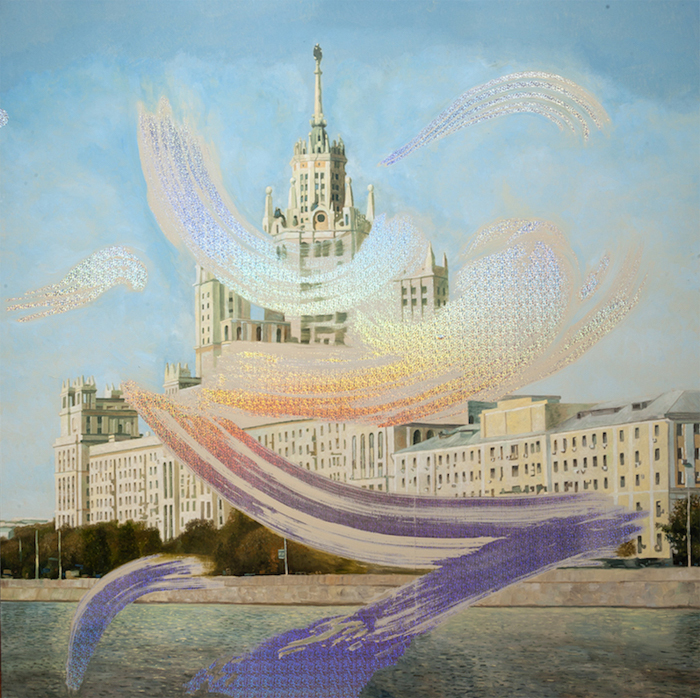Cosmoscow International Contemporary Art Fair is on through 9 September at Gostiny Dvor, Moscow’s Old Merchant Court. Ben Eastham selects his highlights from the fair and the shows that shouldn’t be missed while you’re in town…

Irina Korina, Dreams (Yacht), 2014, mixed media, 150 × 90 × 35 cm. Courtesy the artist and XL Gallery, Moscow
Irina Korina at XL (Moscow)
Irina Korina’s mixed-media sculptures give the impression of having been reclaimed from retrofuturistic domestic interiors in an alternative, chintzier, but recognisably Russian universe. The plush velvet lining a fluffy toy-rendering of a luxury boat, perched like a knobstick on a rudimentary walking stick propped against the wall, recalls, for example, the fabric (my Russian companion tells me) in which Soviet soldiers would carefully upholster the photo albums recording their time in service. Dreams (Yacht) (2014) introduces an at-once irreverent and wistful attitude to the Soviet era, almost beyond the living memory of a new generation, that runs through this year’s fair.

Joanna Piotrowska at Dawid Radziszewski Gallery (Warsaw)
The highlight of an intelligently curated selection of work at the booth shared between Warsaw’s Raster and Dawid Radziszewski is Joanna Piotrowska’s Untitled (2015), a large black-and-white print attached by bulldog clips to the booth’s wall. This image of two young women, linked by legs and arms in the kind of physically intimate and faintly esoteric bonding ritual that teenagers are apt to engage in, communicates the same staged awkwardness that characterises the work of Tereza Zelenkova. The inscrutability of this double portrait contrasts sharply with the poses thrust by fair visitors for the benefit of Instagram (and the lurking suspicion that galleries are designing their booths to translate straightforwardly into that format).

Olga Chernysheva at Temnikova & Kasela (Tallinn)
The work of Moscow-based Olga Chernysheva denotes a similar resistance to the photograph’s diminished role as marker of status (in both the conventional and social-media applications of the word) and straightforward presence – a means of communicating to the world that ‘I am here’. The series of lightboxes collectively titled On the sidelines (2009–10) will be familiar to some visitors, but their folkloric images of chandeliers hung beside the road still conjure something of the magic that Russian literature has always attributed to the natural landscape.
Sergey Sapozhnikov, part of FOMO SAPIENS
Chernysheva’s work offers a more mystical counterpoint to three large-format prints by Sergey Sapozhnikov, who reclaims the collapsed buildings and failed infrastructures of provincial Russia by constructing, and then photographing, precarious, playful and cheerfully bathetic installations from the detritus. They are displayed here at the dismayingly named FOMO SAPIENS section, which brings together works from private collections in a ‘pop-up centre of cognitive practices’ that resembles, to this untrained eye, a configuration of temporary walls and a curtain in a corner of the exhibition hall. As a carefully conceived illustration of contemporary Russian collecting habits it’s nonetheless revealing, featuring work by Philip-Lorca diCorcia, Cyprien Gaillard and Richard Prince alongside the Moscow-based Evgeny Antufiev, Anastasia Potemkina and Alexander Povzner.

Vladimir Potapov at pop/off/art (Moscow)
The combination of brash glamour and brute power that lends Moscow its particular energy finds wry expression in a cycle of paintings by Vladimir Potapov. Each depicts one of Stalin’s ‘Seven Sisters’, the Brobdingnagian skyscrapers that loom over the city, rendered in the Socialist Realist style. These heroic images are overlaid with what appear to be broad painterly gestures in the deconstructed Pop tradition of Roy Lichtenstein’s Brushstroke (1965), but are in fact strips of shiny metallic wrapping paper. The paintings are hardly difficult to decode, but in their embrace of kitsch, their combination of the perennial and disposable, and the sense that maybe it’s ok to have at least some fun in what may not transpire to be, taking into account the traumas that previous generations endured, the end times, they serve as a useful symbol of what distinguishes this Russia and CIS-dominated contemporary art gathering from its equivalents in the West.

If you’re in Moscow for the weekend, don’t miss…
Ilya and Emilia Kabakov: Not Everyone Will Be Taken Into the Future at the New Tretyakov Gallery is a moving retrospective (previously at the Tate Modern and Hermitage) of the artists who trademarked fantastical kitchen sink dream-realism as the appropriate mode for representing contemporary Russian life (read their profile here). At the Pushkin Museum, the loan of Watanabe Kazan’s Dutch-influenced Portrait of Takami Senseki (c. 1830) – a designated National Treasure of Japan – to the exhibition Masterpieces of Edo Paintings and Prints attests to improved relations between Japan and Russia as hopes are raised of a resolution to the long-running dispute over an island chain (similar geopolitical shifts explain the very visible presence of Qatar at Cosmoscow and across the city). Which is all your London-based correspondent in Moscow has to say on the subject of international relations.
Online exclusive published on 7 September 2018
